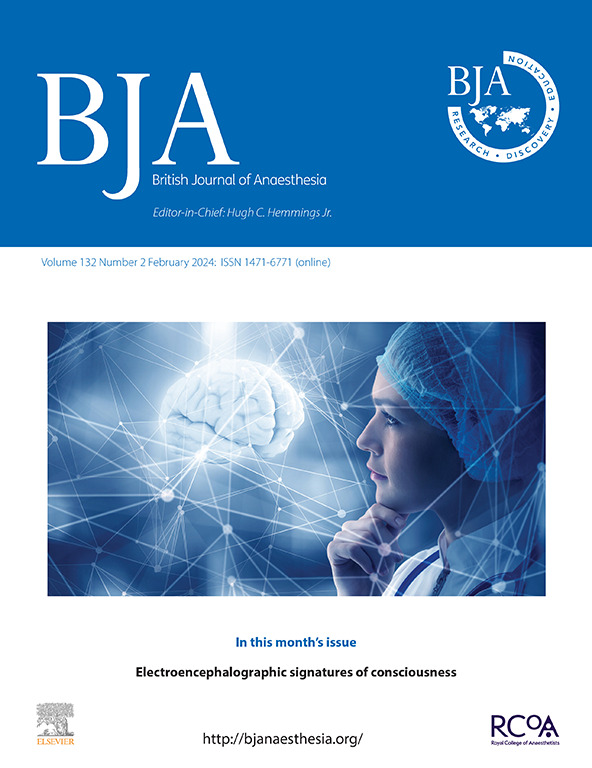Epidural analgesia versus dural puncture epidural analgesia in labouring parturients: a meta-analysis of randomised controlled trials
IF 9.1
1区 医学
Q1 ANESTHESIOLOGY
引用次数: 0
Abstract
Background
Epidural analgesia and dural puncture epidural (DPE) analgesia are widely used techniques for alleviating labour pain. This meta-analysis compared clinical outcomes between parturients receiving epidural analgesia vs DPE analgesia for labour pain.
Methods
Medical databases were searched to identify randomised controlled trials comparing epidural analgesia with DPE analgesia in labouring parturients published up to October 2024. Results were pooled using an inverse variance random-effects model, and 95% prediction intervals were calculated. Clinical outcomes were used as defined by individual trials. The primary outcome was time to onset of analgesia. Secondary outcomes were unilateral block, motor block, sacral sparing, adequate analgesia, Caesarean/operative vaginal delivery, additional doses, and hypotension. The certainty of evidence was assessed using Grading of Recommendations Assessment, Development, and Evaluation guidelines, and subgroup analyses were performed based on the types of local anaesthetics used.
Results
Eighteen trials involving 2144 parturients were included. DPE labour analgesia slightly reduced the time to onset (mean difference: 3.4 min, 95% confidence interval: 2.1–4.7, P<0.01, I2=97%; moderate certainty). All statistically significant results demonstrated clinical advantages for DPE analgesia, including fewer unilateral blocks, reduced motor block, improved sacral coverage, and higher rates of adequate analgesia. Substantial heterogeneity was observed in the outcome data for time to onset of analgesia, unilateral block, and sacral sparing. Pooled results for Caesarean/operative vaginal delivery, additional doses, and hypotension failed to achieve statistical significance.
Conclusions
DPE labour analgesia offers a slightly faster onset and reduced incidence of motor and unilateral blocks compared with traditional epidural analgesia. However, high heterogeneity in some outcomes, likely attributable to clinical and dosing variability, requires cautious interpretation. Although the clinical relevance of the faster onset with DPE analgesia might be modest, when considered alongside its benefits in secondary outcomes it supports the use of DPE analgesia over traditional epidural analgesia. Imputed prediction intervals cross zero for many outcomes, and further studies might alter these findings.
Clinical trial registration
PROSPERO- CRD42024602115.
难产产妇硬膜外镇痛与硬膜穿刺硬膜外镇痛:随机对照试验的荟萃分析。
背景:硬膜外镇痛和硬膜穿刺硬膜外镇痛是目前广泛应用的缓解分娩疼痛的技术。本荟萃分析比较了分娩疼痛接受硬膜外镇痛和DPE镇痛的产妇的临床结果。方法:检索医学数据库,以确定截至2024年10月发表的分娩产妇硬膜外镇痛与DPE镇痛的随机对照试验。采用反方差随机效应模型对结果进行汇总,并计算95%的预测区间。临床结果由个别试验定义。主要观察指标为开始镇痛的时间。次要结果为单侧阻滞、运动阻滞、保留骶骨、足够的镇痛、剖腹产/阴道手术分娩、额外剂量和低血压。采用推荐分级评估、发展和评估指南评估证据的确定性,并根据所使用的局部麻醉剂类型进行亚组分析。结果:纳入18项试验,涉及2144例产妇。DPE产程镇痛稍微缩短了发病时间(平均差3.4 min, 95%可信区间2.1 ~ 4.7,P2=97%;温和的确定性)。所有具有统计学意义的结果都证明了DPE镇痛的临床优势,包括更少的单侧阻滞,减少运动阻滞,改善骶骨覆盖,以及更高的充分镇痛率。在镇痛开始时间、单侧阻滞和骶骨保留的结果数据中观察到实质性的异质性。剖腹产/阴道手术分娩、额外剂量和低血压的合并结果没有达到统计学意义。结论:与传统硬膜外镇痛相比,DPE分娩镇痛起效略快,运动阻滞和单侧阻滞发生率降低。然而,一些结果的高度异质性,可能归因于临床和剂量变异性,需要谨慎解释。尽管DPE镇痛更快起效的临床相关性可能不大,但考虑到其在次要结局中的益处,它支持DPE镇痛优于传统硬膜外镇痛。许多结果的估算预测区间过零,进一步的研究可能会改变这些发现。临床试验注册号:PROSPERO- CRD42024602115。
本文章由计算机程序翻译,如有差异,请以英文原文为准。
求助全文
约1分钟内获得全文
求助全文
来源期刊
CiteScore
13.50
自引率
7.10%
发文量
488
审稿时长
27 days
期刊介绍:
The British Journal of Anaesthesia (BJA) is a prestigious publication that covers a wide range of topics in anaesthesia, critical care medicine, pain medicine, and perioperative medicine. It aims to disseminate high-impact original research, spanning fundamental, translational, and clinical sciences, as well as clinical practice, technology, education, and training. Additionally, the journal features review articles, notable case reports, correspondence, and special articles that appeal to a broader audience.
The BJA is proudly associated with The Royal College of Anaesthetists, The College of Anaesthesiologists of Ireland, and The Hong Kong College of Anaesthesiologists. This partnership provides members of these esteemed institutions with access to not only the BJA but also its sister publication, BJA Education. It is essential to note that both journals maintain their editorial independence.
Overall, the BJA offers a diverse and comprehensive platform for anaesthetists, critical care physicians, pain specialists, and perioperative medicine practitioners to contribute and stay updated with the latest advancements in their respective fields.

 求助内容:
求助内容: 应助结果提醒方式:
应助结果提醒方式:


